PVC Teardrop Bike Trailer

You might recall that I posted a design concept a while back for an ultralight teardrop shaped tiny house trailer that could theoretically be pulled by a bicycle. Shortly after posting the idea I was contacted by The PVC Bike Guy who wants to build such a trailer. In fact he wants to build one out of scrap PVC pipe and reclaimed building materials. So I’ve been spending some time noodling over how I might approach such a design challenge and this is what I have come up with.
As you can see I’m not quite done but the trailer design is ready for a professional review by the PVC Bike Guy. I’m thinking that the shell would be made from 2x4s, plywood, and low-voc foam panels. The curved roof would need to be built-up from layers of thin plywood and foam or foam and fiberglass. Actually if fiberglass were used the entire exterior could be covered which would add a lot of strength to the shell too. I’ll keep working on the details and as always incorporate feedback as it arrives.
Below is one more illustration that shows the PVC pipe trailer frame in finer detail. For those of you playing with Google SketchUp here is the bike teardrop trailer downloadable file.

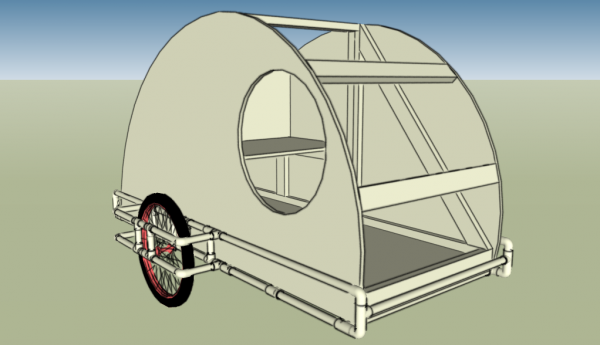
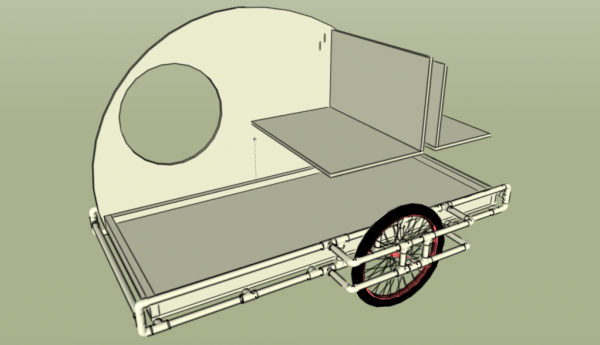
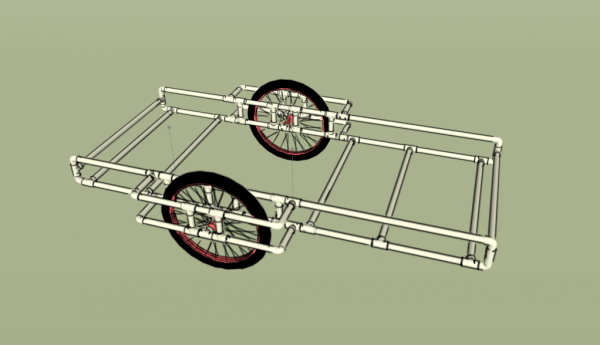
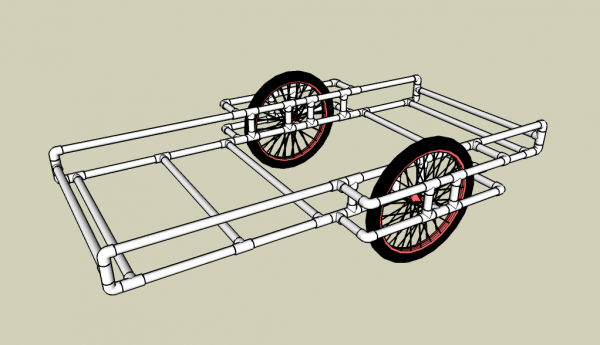
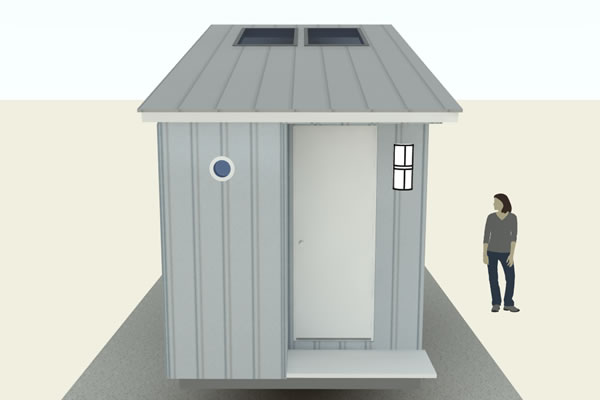
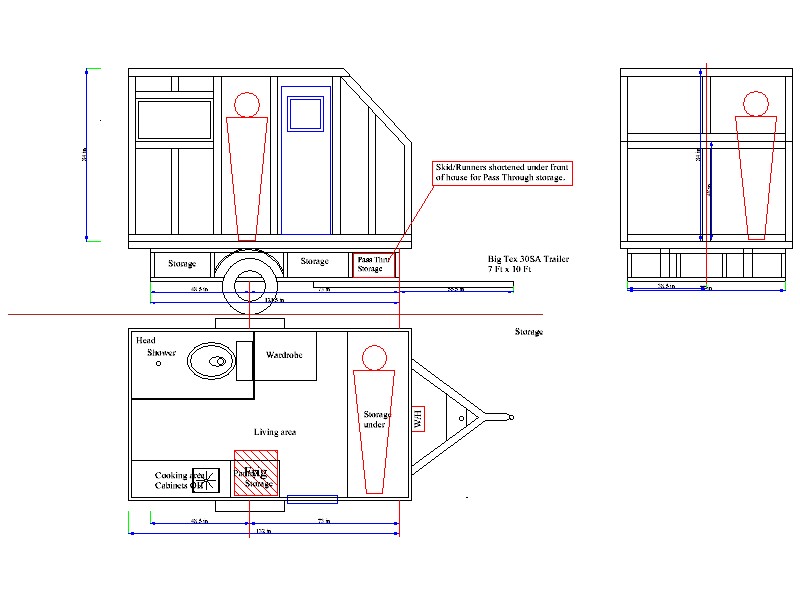
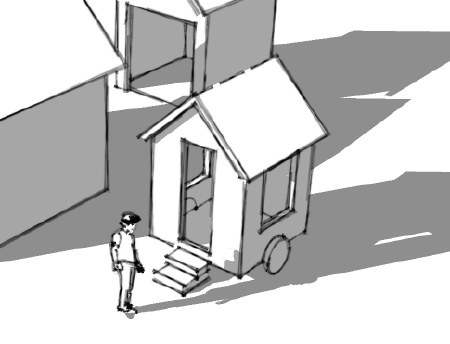
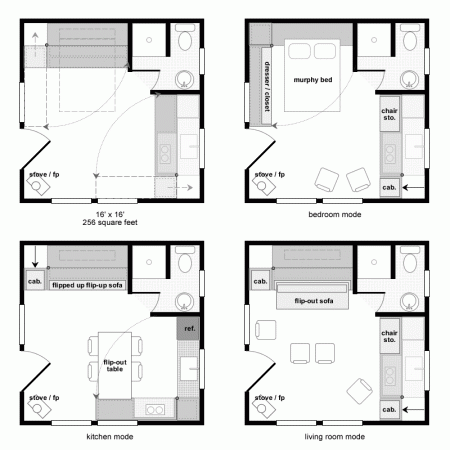
Hey Mike,
Nice SketchUp work.
Being a Treehugger, i appreciate that you're going to use PVC for the structure only and not for the body of the trailer.
Cheers,
Hey Mike,
Nice SketchUp work.
Being a Treehugger, i appreciate that you're going to use PVC for the structure only and not for the body of the trailer.
Cheers,
Triangles make for stronger structors. Try putting 45 degree angles at each of the 4 corners, and run lengths to a center point.
Triangles make for stronger structors. Try putting 45 degree angles at each of the 4 corners, and run lengths to a center point.
Looks really cool.
I think it's a good idea to be able to easily separate the camper from the trailer so that the trailer could be used for hauling other things.
About the camper, how do you get into it?
Looks really cool.
I think it's a good idea to be able to easily separate the camper from the trailer so that the trailer could be used for hauling other things.
About the camper, how do you get into it?
Mike,
I suspect that you could take better advantage of the skins on this unit for diagonal bracing than you are now. You could also take more advantage of the PVC pipe. Consider adding a bowed pipe around the top edge of the sides. Also consider adding pipe cross pieces from side to side instead of using wood. I see no reason why you couldn't eliminate virtually all of the wood framework you are showing by replacing it with PVC pipe. Figure out how to connect the skins to the pipe so that the combined pipe/skin becomes stronger than the simple sum of the parts. If you look at an Airstream trailer you will find that the skin is an integral part of the overall structure. Consider using pop-rivets to attach the skins to the pipe and then perhaps also use a strong construction adhesive where ever the skins and pipe touch. You have the option of having the pipe on the outside or the inside of the skins.
Malcolm
Mike,
I suspect that you could take better advantage of the skins on this unit for diagonal bracing than you are now. You could also take more advantage of the PVC pipe. Consider adding a bowed pipe around the top edge of the sides. Also consider adding pipe cross pieces from side to side instead of using wood. I see no reason why you couldn't eliminate virtually all of the wood framework you are showing by replacing it with PVC pipe. Figure out how to connect the skins to the pipe so that the combined pipe/skin becomes stronger than the simple sum of the parts. If you look at an Airstream trailer you will find that the skin is an integral part of the overall structure. Consider using pop-rivets to attach the skins to the pipe and then perhaps also use a strong construction adhesive where ever the skins and pipe touch. You have the option of having the pipe on the outside or the inside of the skins.
Malcolm
Michael, A few years back I was part of a team involving 3 design students at Uni of Hertfordshire who tackled a boat building project (scale model) inspired by the Troy, NY, USA based Waters & Sons (http://kcupery.home.isp-direct.com/SH.html) paper boats. The thing is the frame for boats and the paper hull covering could well be adapted to make your tear drop trailers. We gave the students rolls of teabag paper, which has excellent wet strength and is very similar to the manila paper the Water's Co used. Therafter we used modern boat building materials to finish off the hulls. The neat thing was the incredible strength of the hulls, surface finish and use of renewable materials. Mark
I see a link to my web site in your post.
This is will soon be a dead link to the paper boat site. In the future you will need to go to: http://www.cupery.net
As I get some traffic from this post, I thought I’d let you know!
Ken
Michael, A few years back I was part of a team involving 3 design students at Uni of Hertfordshire who tackled a boat building project (scale model) inspired by the Troy, NY, USA based Waters & Sons (http://kcupery.home.isp-direct.com/SH.html) paper boats. The thing is the frame for boats and the paper hull covering could well be adapted to make your tear drop trailers. We gave the students rolls of teabag paper, which has excellent wet strength and is very similar to the manila paper the Water's Co used. Therafter we used modern boat building materials to finish off the hulls. The neat thing was the incredible strength of the hulls, surface finish and use of renewable materials. Mark
I'm wondering if some kind of canvas wouldn't work well for the top–perhaps a doped canvas, as has been used for well over a century on airplanes? I'd also want a more rigid axle setup–probably attached to the plywood base of the trailer rather than to a PVC frame, which would tend to deteriorate with the repeated stress, I believe. (If it were for anyone but a PVC fanatic, though, I'd probably not use that for the frame, either. Bamboo, for example, might be superior for the purpose.)
I'm wondering if some kind of canvas wouldn't work well for the top–perhaps a doped canvas, as has been used for well over a century on airplanes? I'd also want a more rigid axle setup–probably attached to the plywood base of the trailer rather than to a PVC frame, which would tend to deteriorate with the repeated stress, I believe. (If it were for anyone but a PVC fanatic, though, I'd probably not use that for the frame, either. Bamboo, for example, might be superior for the purpose.)
My First PVC bicycle I built is well over 7years old and I have not had any stress fractures or problems and it rides as if I just built it the other day it's the red, White and blue one have a look.
http://push.pickensplan.com/photo/photo/listFor…
O and thanks for your comment but any type of tent or canvas will get mildew and leak if touched on the inside and can be tore buy putting up and down repeatably.
My First PVC bicycle I built is well over 7years I have not had any stress fractures or problems and it rides as if I just built it the other day it's the red, White and blue one have a look.
http://push.pickensplan.com/photo/photo/listFor…
O and thanks for your comment but any type of tent or canvas will get mildew and leak if touched on the inside and can be tore buy putting up and down repeatably.
YOU CAN GET WATERPROOF CANVAS…BOAT COVER MATERIAL….AND CAN BE SEALED WITH EPOXY….POOR MANS FIBERGLASS….AS THEY SAY….OR PAINT IF WORRIED ABOUT COST….SUPER LIGHT AND TOUGH…
Hi,
I enjoy reading your blog and thought you might get a kick out of this old time tear droppish trailer pulled behind a tricycle. Here is the web address:
http://blog.modernmechanix.com/mags/PopularMech…
Carey
Hi,
I enjoy reading your blog and thought you might get a kick out of this old time tear droppish trailer pulled behind a tricycle. Here is the web address:
http://blog.modernmechanix.com/mags/PopularMech…
Carey
Nice one Carey. Thanks!
Nice one Carey. Thanks!
I’m homeless and don’t know how to build i wish i could find somone to make me.one
How about a coroplast skin? Election season is coming up, i bet you could get a bunch of it for free right after the election.
Excellent idea jb! Nice use of what will most likely turn into trash too. Good thinking!
You have a good idea going here. I don’t see any means of connecting the trailer to the bike (a tongue) and hold reservation as to whether PVC would be acceptable for that. I tend to think that aluminum might be better suited for that purpose. It might also be the best means of a durable attachment point for the axels. Connecting aluminum tubing to PVC should be relatively easy to do considering pipes can be threaded. For the hinges you can use couplers (coupling links), and if you want the doors to swing even more freely you simply remove the ‘O’rings from inside the couplers before mounting. The bigger issue is creating a lockable door latch. As for the skin … that sould be a no brainer. “Lexan” is a durable light weight surface that can be cut, shaped and bonded in more ways than wood. I would use a 1/4″ – 3/8″ sheet for the floor. Then build the walls with 1/8″ sheets on both sides of the PVC piping for strength and place styrofoam sheets or “Thinsolate”® between them for comfort from the elements. the over all weight will still be less than using wood and it will be insulated, have better resistance to road vibration, and be a little stronger than plywood or fiberglass due to the means of construction. I would also use a double paned “Lexan” window. (“Lexan” is an optical quality polymer that is mistakenly called “Plexiglass” at times.)
D. Card- Lexan may be a good material for this. I just want to add a little clarification regarding terms. Lexan is a brand name for polycarbonate, the tough, clear and nearly unbrekable stuff you’re talking about. Plexiglass, which, looks similar and probably is often confused with Lexan is a brand name for acrylic sheet, which may offer better scratch resistance than polycarbonate (for windows and such) but is much more brittle. Not contradicting here, just clarifying terms.
Thanks for clarifying Cafn8… I didn’t understand the value of the difference (Acrylic sheet may offer better scratch resistance than polycarbonate). Thanks!
But its too long – once you finish the first trial, redesign it as a nested fold out tear drop design. Like a cycle tent trailer, the side that folds out has a “luggage rack” that supports it when folded out, and the wheels support the original base. If you had slices of thirds, it could largely follow your design when unfolded – if quarters, some more dramatic modifications would be required but it would be much more aerodynamic.
Interestingly enough there are only two teardrop bicycle trailer designs out there and for the life of me I cannot figure out why no-one has designed a tricycle with the teardrop shape built in so a trailer isn’t needed in the first place…
How put tire in teardrop?
There is no reason wh the frame cannot be made from thin-wall chromemolly steel tubing, such as is used in some ultralight aircraft. Using chromemolly and covering it with aircraft cloth, and heat shrinking it, will result in a trailer weighing in at less than 150 lbs., probably way less, mabe even as low as 75 pounds. An ultralight aircraft in the US weighs in at 234 pounds, and that includes fuselage, engine, skin, paint, everything. The proposed camper is much smaller than an ultralight airplane.
that is a awsome trailer but how wide is
I am working on a similar concept that could be applicable to both the Bike and for the homeless (3 wheel wagon concept). I am using interior hollow core doors for the walls and ceiling/roof. I am also using 1/2 plywood for flooring with 2×2 flooring support. The interior wall height is actually 39″ due to use of 2×2 for the floor and ceiling attachment… also reinforces the unit for a PVC storage rack on top. The interior width is only 33″. I am using the hollow core doors because they are already pre finished for both the interior and exterior. Also it is easy to recess internal lights and other electronic equipment such as USB Charging Ports, 12 VDC plug/s, and 120 VAC flat style 150 watt power inverter with 3 plugs and additional USB port…all recessed into the wall. Wireing is again easy because it runs through the open space in the wall, and then covered by Styrofoam insulation.
The total weight of the camper would be approximately 120 pounds + the weight of the PVC trailer.
have you finished this and what weight did you achieve? My only experience building a teardrop was a 4×8 that was constructed wit a wooden frame, steel tongue and hard board sides. I used a lot of 1×1 and 1×2 for wall and roof. walls 22#, floor 55# total . This was very light for its size weight 250#.
As was pointed out above either a framework of 1×1 wood or pvc should follow the roof line to provide strength. Luan may be used for paneling- its reasonably light 10-12# per sheet and would need only paint or light epoxy for weatherproofing and incredible strength. I weigh 225 and could walk on my tear roof wit 1×1 and hardboard. I may have to work this out on paper to compare using wood vs PVC. Looks good!
Wheel attachment can be enhanced by using a “T”. The open end allows the nuts to be tightened without having TWO holes drilled into the PVC.
BTW Tent canvas has been used for a LONG time successfully and with proper care lasts a long time in use. I agree with the use of 45 deg. angles for strength. then in the middle a set of 90 deg. elbows. Very light, strong and then useful.